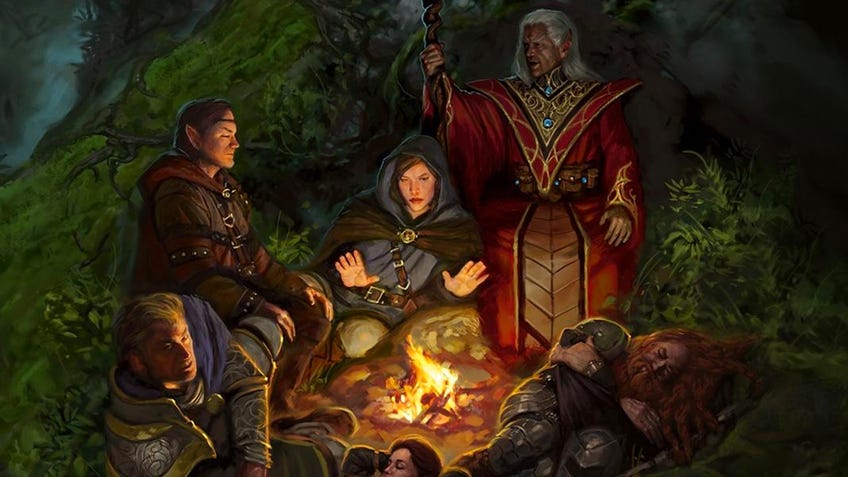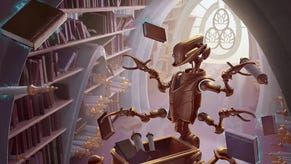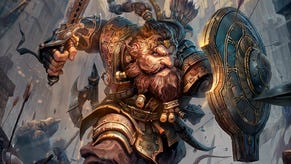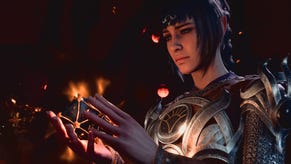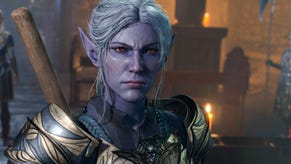Queer players find more than a game in Dungeons & Dragons - they find a safe space
“We are here to play whoever we want to.”
Since its launch in 1974, Dungeons & Dragons has garnered the reputation of a tabletop roleplaying game primarily for straight, cisgender men - a stereotype derived from a bit of truth. But while the game has appeared overwhelmingly homogeneous, there has always been a strong LGBTQ+ community. “I think the perception of it [...] is earned, because that has definitely been the case for a very long time,” says Howl the Mage, a player and dungeon master of over 11 years. “But queers have always been playing D&D, all the way back to the beginning; it’s just [that] we haven't been as vocal and as open and as at the forefront as we are now.”
The changing perception of the RPG is thanks to an uptick of players over the last few years due to everything from mainstream mentions in shows such as Stranger Things and the popularity of actual play series Critical Role to the rise of online platforms like Roll20. With a larger player pool comes more diversity, causing a shift in the game’s demographics and bringing queer players to the forefront of the D&D scene. Between the roleplaying aspects of the base game, the ubiquitous representation of queer stories and an increasingly inclusive foundational framework, Dungeons & Dragons has become not only an enjoyable game for LGBTQ+ players but a queer wonderland.
What’s drawing new queer players to Dungeons & Dragons is the same element that has kept older players around from the beginning: roleplaying in a limitless fantasy world means you can be anyone and do anything - any gender, any style, any sexuality. Dungeons & Dragons allows players to try on different personalities, abilities and bodies without judgement. “Whatever identity you choose for your character, it will be celebrated and respected in-game,” says Sarah Corwin, who has been playing for nine months. “NPCs and party members see me as I want to be seen. [...] It's refreshing, because I get misgendered and misread so much [in real life].”

That freedom is partially thanks to the intrinsic improvisation element of the game; anything goes, and creating strict boundaries is discouraged. By removing expectations, the ability to be whoever you want becomes ingrained in the foundation of D&D and normalised to such a degree that queer players can feel more comfortable exploring their identities because, well, everyone else is too. Because real-world experimentation can be anxiety-inducing or even sometimes dangerous, D&D’s demand for it on a base level creates a space where queer players don’t have to think twice about visibly exhibiting their queerness. “There's no-one at the table who, when you pitch your character, is going to say, ‘But you don't look like that,’” says Ally Beardsley, a cast member on the anthology-style actual play show Dimension 20. “It's just built into the framework of D&D. It’s like, ‘I'm going to present this character, and it doesn't have to look like me, and it's almost better if it doesn't.’”
As I'm going through my own gender stuff, I wanted to play a more aspirational character - potentially future [me].
In their roles with Dimension 20, Beardsley expertly portrays the boundlessness of queer character customisation in D&D. During the series called Fantasy High, they play Kristen Applebees, a “cisgender lesbian [and] a church person” who is an homage to their own experience of growing up identifying as a cisgender lesbian in a religious household. By the time they began filming the next season, The Unsleeping City, Beardsley had begun exploring their gender identity and wanted to portray that new experience in the game. They portray trans man Pete the Plug despite the fact that Beardsley identifies somewhere more outside the binary. “As I'm going through my own gender stuff, I wanted to play a more aspirational character - potentially future [me],” they say.
In fifth season A Crown of Candy, Beardsley explored the LGBTQ+ spectrum even further, choosing to play an identity they weren’t personally familiar with. After having conversations with asexual and aromantic friends, they thought that those identities would make for an interesting character - plus, it would give representation to a identity group largely ignored by mainstream media and society. It’s in this role as Liam Wilhelmina that Beardsley’s approach to character customisation is most exemplified; in Dungeons & Dragons, where you can be anyone, why build a typical character or one that’s expected of you? “We are here to play whoever we want to,” says Beardsley. “For me, it's absolutely shown in a queer light of gender or sexuality.”
As more queer people begin playing D&D, the LGBTQ+ player community grows more visible, which, in turn, appeals to new players because of traditional media’s lack of representation. In LGBTQ+ advocacy group GLAAD’s annual Where We Are On TV report, it was noted that only 9% of characters on television in 2020 were explicitly queer. For movies, that number is slightly better; GLAAD notes that 18.6% of films released by major studios in 2019 contained LGBTQ+ characters. However, when your choice is between media that only marginally features queer stories or a medium that allows queerness to thrive, a few extra percentage points don’t make much of a difference.
Including queer storylines in the campaigns is not a bell or whistle. It's deep in the engine of the story. It makes the whole thing work better.
Actual plays are adding to that representation by bringing queer D&D into the public eye. Noel Daniels, who goes by Dan, is the dungeon master of The Last Tapestry, an actual play podcast with all LGBTQ+ players. While the podcast’s make-up was mostly an accident - the four friends just happened to be LGBTQ+ - Dan says its queerness did allow her to create a safe space for both the players and listeners. Rather than worrying about fitting in, queer actual plays remind people that campaigns can include queerness - and be better for it. “I feel safer listening to an all-LGBT podcast because I know that they're going to be considering things that maybe people who aren't in the community would[n’t],” says Dan.
Brennan Lee Mulligan, dungeon master on Dimension 20, agrees that accurate LGBTQ+ storylines are a necessary part of campaigns. As the queer D&D community grew, he determined that including plots based on queer experiences was the only way to craft relatable, engaging worlds. Dungeons & Dragons is a vast, dynamic universe that stretches across worlds and planes - to say queer content is not a thriving part of that would be ridiculous. It’s why Mulligan finds it so important to bring that experienced-based truth to the world of Dimension 20 through paid queer consultants and aggressive research. “Including queer storylines in the campaigns is not a bell or whistle,” he says. “It's deep in the engine of the story. It makes the whole thing work better.”
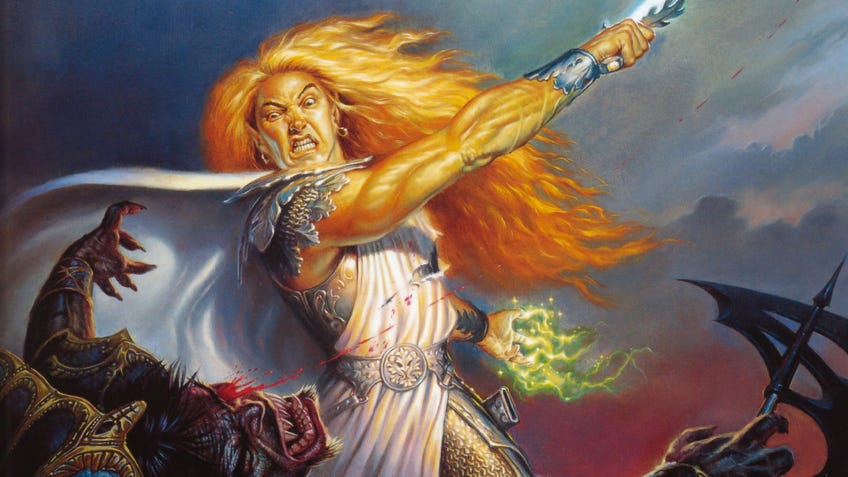
Because the world of D&D is so expansive, and because so many new players have begun demanding better representation, Wizards of the Coast, which has owned Dungeons & Dragons since 1997, has been working to increase official LGBTQ+ inclusion. In 2014, the company adapted its guidelines for character creation to subtly address queer characters in the 5E Player’s Handbook. “You don’t need to be confined to binary notions of sex and gender,” it reads. “Likewise, your character’s sexual orientation is for you to decide.”
Non-playable characters have begun to appear in published modules, including a shopkeeper in 2018’s Waterdeep: Dragon Heist who uses they/them pronouns and corrects players if misgendered. Queer content was written into the game’s lore; one example is the elf god Corellon, who declares that primal elves were able to “assume whatever sex they liked” in Mordenkainen’s Tome of Foes and is described as “androgynous”. While Wizards of the Coast has proved that diverse identities are welcome in the D&D universe, it still has a way to go and recognises that updating the game’s LGBTQ+ inclusion will be a continuously evolving effort. “Making D&D as welcoming and inclusive as possible has moved to the forefront of our priorities over the last six years,” the publisher told Dicebreaker in an email statement. “This part of our work will never end.”
Despite the diversity updates that still need to be made by its creators, a major part of Dungeons & Dragons’ gameplay is that world-building is ultimately at the hands of the dungeon master. Official guidelines are flexible, so LGBTQ+ players can make games as queer as they want, regardless of what the published materials dictate. While D&D ultimately has a core framework and mechanics that make the game what it is, almost everything - not just your character - is customisable. “Whatever kind of world you want to build, there's a way to make it happen within the existing confines of D&D,” says Hannah Lang, who’s been playing for almost a year.
[D&D] allows people to gather and find community and have fun and be happy in an unkind world.
That ability for Dungeons & Dragons to be fleshed out by the dungeon master and players is what has allowed the queer community to both survive and thrive over the game’s lifespan. You can be whoever you want in a world that sees you and respects you regardless of your identity - something that can’t necessarily be said about the world outside the game. D&D allows stories where queer characters flourish, and where your entire existence doesn’t have to be defined by your gender or sexuality (unless you want it to). While the RPG wasn’t intentionally created to appeal to queer players, it has become a safe haven for the community - one where LGBTQ+ life is not only accepted without pushback but fully normalised.
“[D&D is] a game which allows people to gather and find community and have fun and be happy in an unkind world,” says Corwin. “This is a big pull for lots of queer people who can't find that kind of safety elsewhere.”
